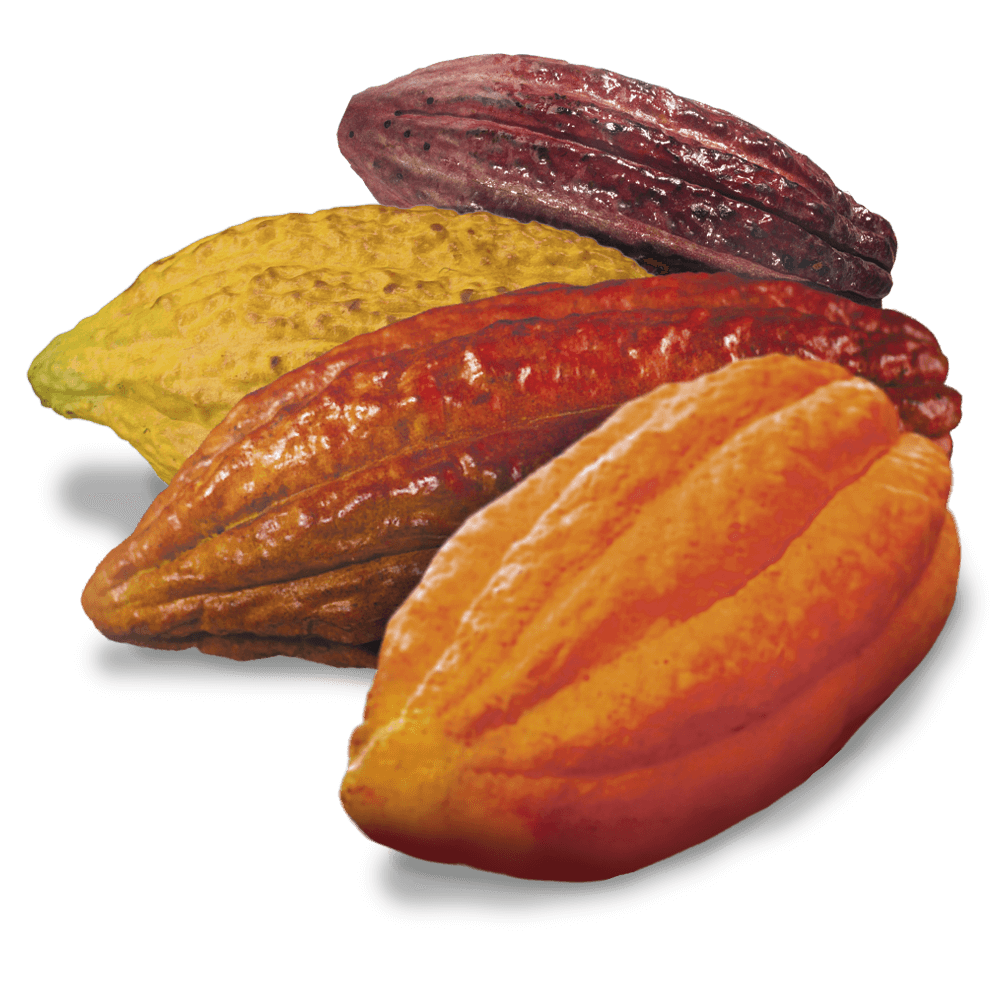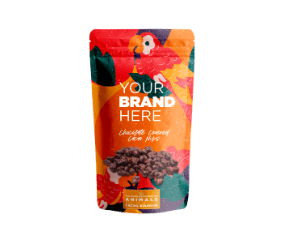WELCOME TO THE LUKER CHOCOLATE WORLD
Our Chocolate Is unique

100% Fine Flavour Cocoa
We work exclusively with Cacao Fino de Aroma, a special type of cocoa classified by the International Cocoa Organization (ICCO) for its fruity, flowery and nutty malt notes.
Only 8% of the cocoa produced in the world is Cacao Fino de Aroma, 76% of which is produced in Colombia, Peru, Ecuador and Venezuela.
We ensure a superior flavour when using Cacao Fino de Aroma and guarantee sustainability, transparency, supply and traceability in our processes to integrate the entire value chain; from the first seed, to the final product.

Crafted at Origin
For more than a century, we have developed an in-depth knowledge of terroir and how to express the unique characteristics found in Fine Flavour Cocoa, in our chocolate recipes.
Luker chocolates are crafted in our manufacturing plant in Colombia, and start with a selection of the best single origin cocoa beans, which reflect the Diversity of our land. Discover our rich portfolio of Selected Origins and Heritage Recipes.
We are a chocolate supplier serving international markets with the following set of chocolate portfolios.

Heritage Recipes
Our Heritage Recipes reflect more than 100 years of experience mastering Cacao Fino de Aroma, and developing unique recipes to cater to specific market needs and applications. You will find a wide range of white, milk and dark chocolates with particular flavour and performance characteristics.

Balance
An innovative set of chocolate answers health concerned consumer needs with alternative ingredients such as natural sugars, plant based dairy alternatives and functional ingredients.
CHOCOLATE RELATED
Can I consume chocolate after the expiration date?
If you stored it in a cool place with no sun exposure the properties have not changed that much. However, if you want to keep the consistency in the flavour profile of your products we would recommend buying coverture that has not met its expiration date.
Why are metals such as cadmium and lead present in some food products including chocolate?
The presence of cadmium and lead in soils is often a result of a combination of natural processes and human influences.
Is there specific regulation in the US to limit the content of these metals in food? What regulation exists for chocolate?
Federal agencies like the Food and Drug Administration and the Environmental Protection Agency have set levels for safe consumption of metals such as lead or cadmium. However, California’s Proposition 65, officially known as the Safe Drinking Water and Toxic Enforcement Act of 1986, is currently the most rigorous law in this matter. Prop 65 set levels of cadmium and lead for food products in different categories.
In chocolate, an agreement reached by “As You Sow” (Consumer Advocacy Group) and the chocolate industry, resulted in specific thresholds defined for chocolate under Prop 65. This agreement resulted from the parties’ acknowledgement of the limited contribution of cadmium and lead found in chocolate to a person’s diet, the natural origin of the cadmium and lead found in cocoa as well as the difficulty to remove them. Thus, chocolates with cadmium and lead levels below the following limits are not required to include any warning level.

*Note these levels are not the ones used as baseline by Consumer Reports in their Dec 15th 2022 article.
What is Luker doing to monitor the levels of heavy metals in our chocolates?
Cocoa beans analysis: 100% of the cocoa beans used in our chocolates are analyzed for cadmium. We also conduct a bi-annual analysis for lead presence on an aleatory sample of cocoa beans from the different regional origins used.
Chocolate analysis: 100% of all the chocolates we produce for export are analyzed for cadmium levels ensuring each product is in compliance with cadmium regulations applicable at the destination market.
Control capabilities: We have invested in a state-of-the-art cadmium control laboratory using Flame Atomic Absorption Spectrometry (FAAS) methodology. Our laboratory is currently in the process to obtain international accreditation (Mar/2023).
What is Luker doing to solve the issue of heavy metals in chocolate?
We have defined 3-prone approach to solve this issue: traceability, segregation & reduction.
Traceability: Since 2012 we have been developing a complex mapping system of cadmium presence in the different regions of Colombia, connecting this information to cocoa beans coming from these regions to inform product design.
Segregation: We have in place an agricultural development strategy to segregate the cacao with high content of cadmium, analyze and understand causes.
Reduction: We are perhaps one of the most advanced companies in the world in cadmium reduction and remotion related research. We have designed a two-way research approach: On one end, using biotechnology to identify microbes in fermentation with potential to reduce cadmium in cocoa beans. On the other, using nanotechnology to reduce cadmium in cacao mass through lipids and other cadmium chelator molecules. These technologies have shown promising results for near future application.
What is the difference between dark, milk and white chocolate?
Chocolate is usually made from cacao liquor and sugar this is what we called dark chocolate, sometimes we want a more creamy and indulgent option here is when we add milk to this formula and the milk chocolate rise out of this need. Finally, white chocolate is an option for those who might want to stay out of the cocoa liquor, so we only add cocoa buttermilk and sugar to make this very unique white chocolate.
What is a chocolate couverture?
Our chocolate couverture is a REAL chocolate ingredient that can be dark, semi-dark, milk or white based chocolate used for multiple applications that can go from moulding up to the bakery and creating the world’s favourite desserts. Do not confuse it with a chocolate compound coverture.
Is the intake of cadmium and lead harmful to human health?
According to the Food and Agriculture Organization of the United Nations (FAO) and the World Health Organization (WHO), according to a study carried out last 2021, the tolerable levels of cadmium intake per month (PTMI) is around 25µg/Kg BW. (body weight)/month. This considering all foods in a person’s day to day.
Reported national estimates of mean dietary exposure to cadmium from all foods for adults, ranged from 2.2 to 12 μg/kg bw per month, or 9%–48% of the PTMI. Likewise, the study concludes that chocolate only contributes between 0.1% – 9.4% of this amount, even in countries with a high intake of cocoa.
Why are there chocolates with higher cadmium/lead content?
Cocoa content: The presence of heavy metals in chocolate is mostly associated with the cocoa solids in the formula. Thus, it is natural that the higher the cocoa percentage, the more likely it is to find higher levels of cadmium and lead. It is also important to note that higher percentage cocoa content also comes with higher antioxidant levels and other health benefits associated with chocolate.
Genetic origin: As the cocoa plant naturally absorb heavy metals from the soil, research and empiric evidence has shown that some cocoa varieties have higher absorption capacity. This may influence the result.
Geographic origin: there is evidence that soil composition is a factor that may influence the cadmium and lead levels in the soil. For example, in Latin America, higher levels of cadmium reported in cacao beans relative to other regions, implies that the soils in some areas may be naturally rich in cadmium or have characteristics that lead to its higher bioavailability. These differences may even be found in neighboring regions.
Human influences: presence of heavy metals in chocolate can also be caused by the agricultural practices in place and environmental contamination caused by mining and other activities in the area.
How does this influence our sourcing practices?
PRODUCT RELATED
What are Luker Chocolate’s Sugar-Free chocolates sweetened with?
We have developed different combinations to match different regions’ trends and needs. Therefore, we can craft a sugar free chocolate that would make your ideas happen. The sweeteners we are currently using could be an Erythritol + Stevia mix, Maltitol and Allulose.
Are our sugar free chocolates suitable for Any Diet?
Our sugar-free chocolates are sweetened with sweeteners suitable for diabetes, However, we recommend to our consumers to check with their doctor or nutrition specialist to review whether the ingredients are suitable for each one diet.
What is a “No Added Sugar” Chocolate?
We want you to know that there are ways to enjoy creamy and sweet chocolate without compromising your sugar consumption that is why we developed milk chocolate sweetened with Erythritol and stevia with milk which naturally has Lactose sugars in it which is the only source of sugar from this chocolate.
What makes our Chocolate “Nevado” a Real White Chocolate?
Our White Chocolate Nevado is made with natural cocoa butter which is not deodorized as usually happens with white chocolates around the world. This special twist maintains all the true flavour notes of chocolate while having an exotic colour and tone that makes it so special.
Does the plant-based portfolio temper/work/flow the same as regular milk chocolate?
It tempers as dark chocolate since the oat doesn’t have any extra fat as dairy milk does while maintaining a creamy texture. Isn’t that amazing?
What is the difference between “Sugar-Free” And “No Added Sugar” Chocolates?
Sugar-free means there is no sugar present in the product.
No added sugar means that no sugar was intentionally added to the product but given the characteristics of the raw materials they have natural sugars in them (Basically, Milk).
Do our Sugar-free Chocolates contain any allergens?
Yes, the first allergen you would find in our sugar-free chocolate is soy which is present in all our sugar-free chocolates to give them the perfect fluidity you would need. Also, our “No Added Sugar” chocolate has milk on it being an additional allergen in this product.
Why our OATM!LK chocolates are vegan friendly?
We are part of the alternatives food revolution bringing a different offer of m!lk chocolates with no animal or animal derivate ingredients added.
What is a Natural alternative to sugar and which ones do we offer?
The kind of sugar we are consuming affects the way our body responds to these carbohydrates therefore natural sugars are so important on diets for those that are conscious of their health. Natural sugars are easily found as fructose in fruits while regular sugar is more processed and have different types of carbs.
Is the plant-based portfolio vegan-friendly and/or dairy free?
Our Oat M!lk chocolates are suitable for vegan consumption as they don’t have milk or animal-originated ingredients. However, they are not categorized as “Dairy Free” as they may contain traces of milk since the chocolate is produced with the same equipment as other chocolates in our portfolio. To manage cross-contamination, we have a thorough HACCP Allergen control plan.
How can I have some of your chocolate?
To place an order, state the nature of your business with our sales team. Use the comment box to tell us any specifics about your requirement. We will give you specific times for your location and the required quantity.
CHOCOLATE PRODUCTS BY CATEGORY

CHOCOLATE
INGREDIENTS
All of our chocolate ingredients guarantee a unique flavor that is given by the pureness of its origins. Carefully selected beans from different Cacao Fino de Aroma growing regions. Its flavor does reflect not only the cocoa variety but also the richness of the soil and the growing culture of its regions.

Private Label
Chocolates
From chocolate bars to healthy chocolate snacks, Luker Chocolate can help you formulate, manufacture and design high-quality chocolate products for your customers. All with our Cacao Fino de Aroma signature taste.
we are present in the whole cocoa value chain

SOURCING

PROCESSING

MOULDING

PACKAGING
OUR CERTIFICATIONS






*Certifications may vary depending on your product


